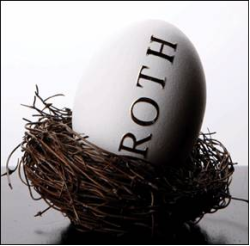Roth IRAs have many rules and benefits, so boiling them all down to a list of just three isn't easy. Inevitably, there will be important information you should consider that's not on this list. That said, by simply knowing these three rules, you'll have a pretty good idea of whether or not you should be having the "Roth Talk."
1) Tax-free Distributions in Retirement Come With an Upfront Cost
Perhaps the biggest benefit of the Roth IRA is that it allows for the possibility of tax-free distributions of retirement savings. Once you reach the point where you are able to take a "qualified distribution" from your Roth IRA, everything that comes out of any of your Roth IRAs for the rest of your life will be tax and penalty-free. In order to have a qualified Roth IRA distribution, you must generally have started your first Roth IRA more than five years ago and you must be over age 59 1/2. There are a few other ways you can get to qualified distribution status, but those are generally best discussed with your tax and/or financial advisor.
 Now it's hard to find someone who doesn't like the sound of "tax and penalty-free," but getting money into a Roth IRA generally isn't free. Instead, it comes with an upfront cost. If you're making regular Roth IRA contributions, that cost is the loss of the tax deduction you may have otherwise received by contributing the same funds to an IRA, 401(k), or other pre-tax retirement plan. If, on the other hand, you’re converting retirement money to a Roth IRA, you must add the converted funds to your income in the year of conversion. Thus, your tax bill for that year may increase significantly but... the allure of future tax and penalty free income may be worth it. This, again, is a conversation worth having with a professional.
Now it's hard to find someone who doesn't like the sound of "tax and penalty-free," but getting money into a Roth IRA generally isn't free. Instead, it comes with an upfront cost. If you're making regular Roth IRA contributions, that cost is the loss of the tax deduction you may have otherwise received by contributing the same funds to an IRA, 401(k), or other pre-tax retirement plan. If, on the other hand, you’re converting retirement money to a Roth IRA, you must add the converted funds to your income in the year of conversion. Thus, your tax bill for that year may increase significantly but... the allure of future tax and penalty free income may be worth it. This, again, is a conversation worth having with a professional.
2) There are no Required Minimum Distributions During Your Lifetime
To many, the second biggest benefit of Roth IRAs, right behind the tax-free distributions, is the fact that during a Roth IRA owner's lifetime there are no required minimum distributions (RMDs). This gives you the ability to allow your Roth IRA money to grow tax-free as long as possible and, contrary to traditional IRAs, it allows you to take income when you want it, not when Uncle Sam tells you that you must take it. A recent proposal calling for Roth IRA RMDs was included in the President's 2015 Fiscal Year Budget, but it's unlikely to actually happen any time in the near future.
If you're survived by a spouse after your death, they can generally roll your Roth IRA into their own Roth IRA, where they will continue to have no RMD requirements during their lifetime. Ultimately, when your IRA is left to someone other than a spouse, they will have to begin taking RMDs in the year after the year they inherited the account. Those distributions, however, will generally be tax-free.
3) You Can Always Access Your Contributions Tax and Penalty Free
When it comes to Roth IRAs, there's three types of money. There are contributions, which are the funds you put directly into a Roth IRA, there are conversions, which are the funds you've moved to a Roth IRA from a tax-deferred retirement account, like an IRA or 401(k), and there are earnings, which are the growth on your contributions and your conversions. The rules for conversions and earnings, are a bit more complicated, but the rules for Roth IRA contributions are about as simple as it gets when it comes to the tax code. They can be withdrawn at any time tax and penalty free. On top of that, they are also considered to be the first money out of your Roth IRA.
So, for instance, suppose you made a $20,000 Roth IRA conversion five years ago that's now worth $28,000. Last year, you made a $5,000 Roth IRA contribution. In our example, you can take out up to $5,000 out of your Roth IRA at any time tax and penalty free. It doesn't matter if you are under age 59 1/2 or not. It doesn't matter for what purpose you're withdrawing the funds. It doesn't matter that the $20,000 conversion was made before you made your contribution. It doesn't matter if... well, you get the point. No matter what you do, the first $5,000 you take from your Roth IRA will be tax and penalty free.
- By Jeffrey Levine and Jared Trexler
1) Tax-free Distributions in Retirement Come With an Upfront Cost
Perhaps the biggest benefit of the Roth IRA is that it allows for the possibility of tax-free distributions of retirement savings. Once you reach the point where you are able to take a "qualified distribution" from your Roth IRA, everything that comes out of any of your Roth IRAs for the rest of your life will be tax and penalty-free. In order to have a qualified Roth IRA distribution, you must generally have started your first Roth IRA more than five years ago and you must be over age 59 1/2. There are a few other ways you can get to qualified distribution status, but those are generally best discussed with your tax and/or financial advisor.
 Now it's hard to find someone who doesn't like the sound of "tax and penalty-free," but getting money into a Roth IRA generally isn't free. Instead, it comes with an upfront cost. If you're making regular Roth IRA contributions, that cost is the loss of the tax deduction you may have otherwise received by contributing the same funds to an IRA, 401(k), or other pre-tax retirement plan. If, on the other hand, you’re converting retirement money to a Roth IRA, you must add the converted funds to your income in the year of conversion. Thus, your tax bill for that year may increase significantly but... the allure of future tax and penalty free income may be worth it. This, again, is a conversation worth having with a professional.
Now it's hard to find someone who doesn't like the sound of "tax and penalty-free," but getting money into a Roth IRA generally isn't free. Instead, it comes with an upfront cost. If you're making regular Roth IRA contributions, that cost is the loss of the tax deduction you may have otherwise received by contributing the same funds to an IRA, 401(k), or other pre-tax retirement plan. If, on the other hand, you’re converting retirement money to a Roth IRA, you must add the converted funds to your income in the year of conversion. Thus, your tax bill for that year may increase significantly but... the allure of future tax and penalty free income may be worth it. This, again, is a conversation worth having with a professional.2) There are no Required Minimum Distributions During Your Lifetime
To many, the second biggest benefit of Roth IRAs, right behind the tax-free distributions, is the fact that during a Roth IRA owner's lifetime there are no required minimum distributions (RMDs). This gives you the ability to allow your Roth IRA money to grow tax-free as long as possible and, contrary to traditional IRAs, it allows you to take income when you want it, not when Uncle Sam tells you that you must take it. A recent proposal calling for Roth IRA RMDs was included in the President's 2015 Fiscal Year Budget, but it's unlikely to actually happen any time in the near future.
If you're survived by a spouse after your death, they can generally roll your Roth IRA into their own Roth IRA, where they will continue to have no RMD requirements during their lifetime. Ultimately, when your IRA is left to someone other than a spouse, they will have to begin taking RMDs in the year after the year they inherited the account. Those distributions, however, will generally be tax-free.
3) You Can Always Access Your Contributions Tax and Penalty Free
When it comes to Roth IRAs, there's three types of money. There are contributions, which are the funds you put directly into a Roth IRA, there are conversions, which are the funds you've moved to a Roth IRA from a tax-deferred retirement account, like an IRA or 401(k), and there are earnings, which are the growth on your contributions and your conversions. The rules for conversions and earnings, are a bit more complicated, but the rules for Roth IRA contributions are about as simple as it gets when it comes to the tax code. They can be withdrawn at any time tax and penalty free. On top of that, they are also considered to be the first money out of your Roth IRA.
So, for instance, suppose you made a $20,000 Roth IRA conversion five years ago that's now worth $28,000. Last year, you made a $5,000 Roth IRA contribution. In our example, you can take out up to $5,000 out of your Roth IRA at any time tax and penalty free. It doesn't matter if you are under age 59 1/2 or not. It doesn't matter for what purpose you're withdrawing the funds. It doesn't matter that the $20,000 conversion was made before you made your contribution. It doesn't matter if... well, you get the point. No matter what you do, the first $5,000 you take from your Roth IRA will be tax and penalty free.
- By Jeffrey Levine and Jared Trexler











